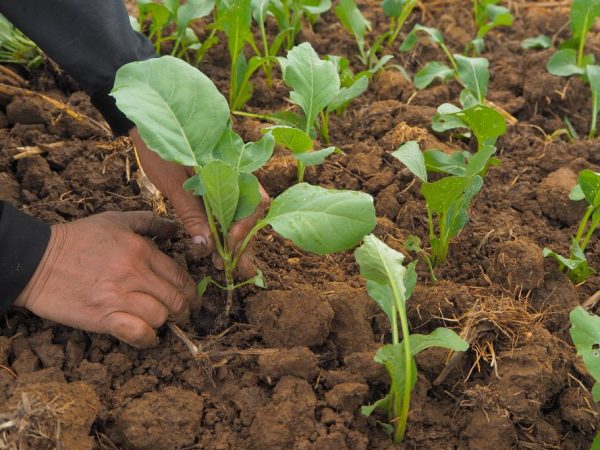Kilaton cabbage variety
Kilaton white cabbage is a popular high-yielding variety that is easy to care for. The vegetable is planted outdoors from seedlings or seeds. Cabbage gets sick with improper care, and spraying with special solutions is used to protect it.

Kilaton cabbage variety
Variety characteristic
Description of Kilaton cabbage:
- A late-ripening hybrid variety is planted in late spring.
- The average planting density is 35 tons per hectare.
- The growing season of cabbage is 130 to 135 days.
- The variety is resistant to keel and pinpoint necrosis, which allows keeping the head of cabbage for a long period.
Description of fruits
Cabbage Kilaton f1 has a massive head of cabbage. The weight of one vegetable is 3 to 4 kg. The upper leaves are dark green, the lower ones are lighter. The surface of the head of cabbage is smooth and leveled.
General description of a head of cabbage:
- round shape;
- leaves are dense and keep their shape;
- the growing season is average.
The product is used both raw and pickled. The head of cabbage is stored in a cool dark room for several months.
Planting and growing
Cabbage is planted in two ways: seedling and non-seedling. For seedlings, seeds of a certain size are selected: from 1.4 to 1.5 mm. Before planting, they are placed in warm water for half an hour. Soaking the cultivar hardens to prevent infection. After that, the planting material is immersed in cold water for 2-3 minutes. At the end, the seeds are well dried.
Hybrid f1 is planted for seedlings not earlier than April. Planting material is placed in pots and left in a warm room (in a greenhouse or on a windowsill). For fast germination of seeds, soil mixtures are needed. A mixture of peat, earth and sand is used (the main part of the soil is peat). The seedless method consists in planting seeds directly into open ground. This planting is carried out later (closer to May), when the soil warms up well.
Transplanting

Seedlings must be buried at the first leaf.
For seedlings of the f1 hybrid, pots with a depth of at least 8 cm are used. The seed hole is 1-3 cm.Immediately after planting, the seeds are watered.
The first shoots appear within a week. After the appearance of a green stem, mineral fertilizers are applied to the soil (organic matter cannot be used). Seedlings are well watered.
Landing in open ground is carried out after 35-40 days. Holes are made in the soil. Each hole is watered with at least 0.5 liters of water. The seedlings are deepening to the first leaf. The optimal distance between the beds is at least 50-70 cm. The distance between heads of cabbage does not exceed 40-50 m.
Sprout care
According to the description, Kilaton cabbage is well fertilized at all stages of growth. The first time the fertilizer is applied after the first leaf appears in the seedlings, then on the 12th day. The last time the seedlings of the f1 hybrid are fed 2 days before planting in open ground. To make the variety quickly take root in the garden, use homemade top dressing.
Mix composition:
- 3 g of ammonium nitrate;
- 1 g of potassium chloride;
- 4-5 g superphosphate.
The dry mixture is diluted with 1 liter of purified water. Top dressing is applied to the top layer of open ground. As the head of cabbage of the Kilaton variety grows, the amount of active substances increases. Basic care includes watering once a week. To increase the yield, Kilaton is huddled. The soil is loosened to a soil layer of at least 8 cm. Weeds are removed during the entire growth period.
A variety with large heads of cabbage needs frequent watering. Head of cabbage in unfavorable soils, therefore, when planting seedlings, additional fertilization is carried out. The quality of the crop depends on the conditions.
Diseases and pests
Kilaton cabbage suffers from pests and infectious diseases. The cabbage moth appears on the head of cabbage at any stage of its growth. Caterpillars or pupae appear, which eat the upper leaves. Moth eggs are located on the underside of the leaves. The more overgrowth of the moth, the more damage to the head of cabbage.
Cabbage aphids and flies attack young heads of cabbage. Cabbage changes the color of the upper leaves, and lesions are formed in the root part. The size of cabbage aphids is no more than 3 mm, and they cannot be removed mechanically. The size of the fly is up to 6 mm. Slugs and snails can damage cabbage crops. Slugs make holes in the leaves and leave mucus on the green part of the head of cabbage.
Disease and pest control
To combat cabbage moth, mixtures with calcium and chlorophos solution are used. The moth spreads in beds with a lot of weeds. Weeding helps prevent the spread of pests. Soap solution or milk serum helps to destroy cabbage aphids (the surface of seedlings or head of cabbage is wiped with a damp cloth).
To combat cabbage fly, a mixture of tobacco, wood ash and ground pepper is used. To save cabbage heads from slugs, 2-3 Thunder granules are installed under each cabbage (at night).
Conclusion
The Kilaton hybrid is recognized by gardeners as one of the most profitable late varieties. It does not require special care and has good yield indicators. The ripening period of the culture is late: not less than 140 days. At the same time, heads of cabbage have a long shelf life. Vegetables can be grown both in a vegetable garden and on an industrial scale.

